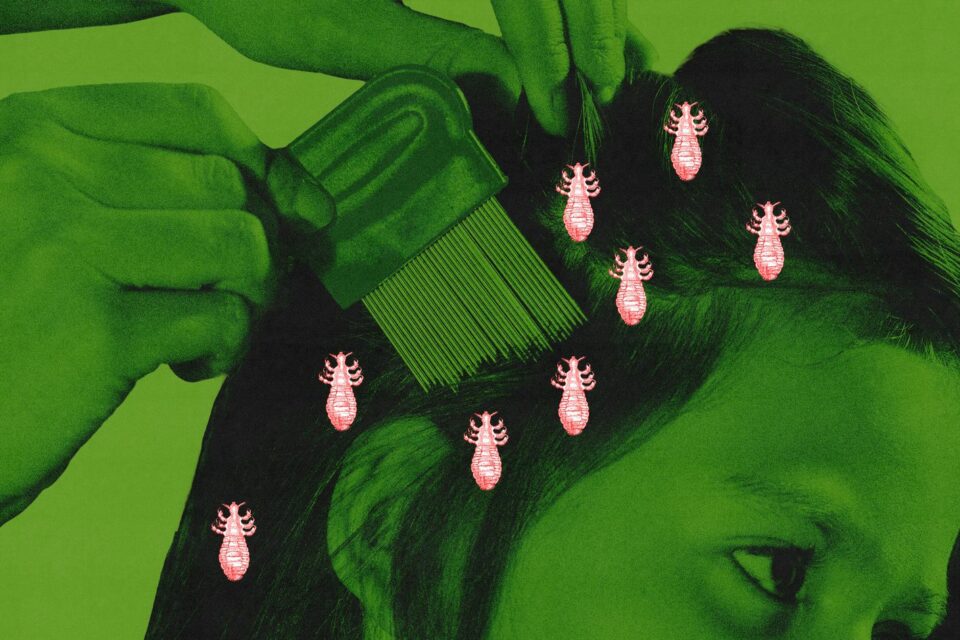Photo-Illustration: The Cut; Photos Getty Images
When I discovered that my family had lice — and I mean full-on lice, bugs crawling around on all our scalps except my husband’s — I thought I could handle it on my own. This turned out not to be the case. Two days after we shampooed everyone with over-the-counter Nix and fine-tooth combed every visible speck and bug out of everybody’s hair, did all the laundry, quarantined the head-proximate stuffies, and vacuumed everything our heads had touched, our babysitter texted to tell us she had seen a bug crawling around on my 9-year-old son Raffi’s head. She, understandably, was freaking out, and soon so were we. We’d both planned to go out the following night, which was off the table now (we’ll be lucky if she ever babysits for us again), and we then understood that combing and shampooing at home were not going to be enough to vanquish our unwelcome new houseguests. After one more try with the Nix because there was still some left in the bottle, we made appointments the next day at the Gowanus location of LiceBusters, one of New York’s several thriving lice-elimination services.
As he did the final pass through my long hair with a comb and buckets of Pantene sprinkled with baking soda, LiceBusters owner Daniel Harel told me that his business was booming. Lice, which had spent the pandemic as quietly quarantined as the rest of us, were now back in full force, and maybe worse than ever. His theory, he explained to me later, is that many schools stopped hiring companies like his to come in and do lice checks on their students when school went remote and have only recently started back up again. Now that LiceBusters is back in schools, he’s seeing more lice there than ever before: “Normally, before COVID, about 5 percent of the school would have lice, but now we do some schools where 20, 30 percent of the school has lice. It’s gotten so bad.” A number of other companies that do routine lice checks in schools are also seeing worse lice outbreaks now than in previous years.
At his clinic, where he and his staff perform checks, comb-throughs, and a final shampoo and blow-dry, Harel is seeing up to 100 or 150 people on a busy day. “Most of the people that are trying to treat it at home, the quickest and easiest thing for them to find is the pesticide in the pharmacy. But those are proven not to work,” he says. This is because they kill the living lice only on the scalp, and to fully treat an infestation, the sticky eggs attached to the root of the hair also have to be thoroughly combed out, a process that isn’t effectuated by any of the shampoos on the market. And most people don’t have the training or dedication necessary to spend the requisite amount of time combing globs of thick conditioner through their own and their kids’ hair to get every last nit.
Professional treatment may be the best course of action, but for many people it’s prohibitively expensive, even though some of the costs may be defrayed by health insurance. (I paid for my own treatment, which came to $250, directly from my HSA.) For a full family with lice, you’re looking at a thousand-dollar price tag for the service, some or all of which may not end up being reimbursed by your insurance provider.
Normally, before COVID, about 5 percent of the school would have lice, but now we do some schools where 20, 30 percent of the school has lice. It’s gotten so bad.
Brooklyn mom Carol Cohen, who has used the service twice in the past year, is fed up with the high price of continued lice infestation. She has two school-age sons, both of whom have had bugs and eggs on their scalps repeatedly since their first go-round, which happened after a trip last fall visiting various family friends. “We got lice in California, brought it to Italy, and then brought it back here,” she says. Like me, Cohen first tried to treat the problem at home, then ended up resorting to a professional service. Then, a couple of months later, she spotted nits on her younger son at the playground and had to go through the whole shebang (and the full $1,000) again. This time around, she feels as though she has observed the process in detail well enough to be confident that she can handle the infestation she’s currently dealing with on her own with Pantene and comb at the ready. “The first time we had it, I was like, Sure, it’s a lot of money. But we did it, and now we’re fine. But this time around, where it’s like I had to do it and then I had to do it a month later, I was just like, No, no. That’s two grand, and now it would be three grand,” she says. “When you pay that much money, you are like, Okay, I’ve paid the money. So I’m sure that they know what they’re doing. But really — no offense to them, but they’re just some people that are used to looking at lice all day.”
Georgia Kral, who lives in Montclair, hired a service called Lice Happens to come over to her home when her 8-year-old daughter was sent home from school with lice. For $300, the woman used an enzyme treatment designed to loosen nits from the hair shaft and did a thorough comb-through; Kral estimates that it took about two hours. The Lice Happens lady instructed her to do another comb-through the next day, during which she discovered two nits and freaked out all over again: “I was like, Oh my God, she didn’t get them all. But the lady was so consumer-focused that she was like, ‘Text me tomorrow a picture of what you find.’” She reassured Kral that it was normal to continue to find nits, and Kral felt better. Repeated comb-throughs came up empty, and the infestation didn’t spread to any other members of Kral’s family, so she decided the service had done a good job. She still checks her children’s heads once every couple of weeks for nits, knowing that the school won’t reliably inform her if there’s an outbreak in one of her children’s classes — last time, she was told a note was sent home, but she never received it.
Pediatrician Philippa Gordon advises parents who don’t want to go the professional route to use a prescription insecticide called Ovide: “It kills the adults and the nits, so you don’t have to bother removing any nit you may see after treatment.” (It’s also malathion, which she says is the only pesticide allowed on farms transitioning from conventional to organic agriculture because of its low toxicity.) The next best thing, if Ovide isn’t available, is to use an over-the-counter remedy like Nix every day for five to seven days, combing out adult lice and nits afterward, even though it doesn’t kill the nits. “If you keep removing all the adults, eventually you will prevail,” Gordon says. She’s not totally convinced of the necessity of shelling out so much cash for professional services: “It’s expensive and time-consuming, but many families swear by them.” Then again, delousing at home is also time-consuming — and at least with the pros, you can feel a sense of relief at having outsourced the problem.
I know I felt good on the day of my professional delousing, even as I spent the remainder of my workday reeking of Pantene and with a slight powdery residue of baking soda trickling down my temples as it mixed with my sweat. It was mildly unpleasant, sure, but it was nothing compared to the creeping body horror that is knowing you’re walking around with bugs in your hair.
Related
The Cough That Doesn’t End
Emily Gould , 2024-06-19 13:00:57
Source link


